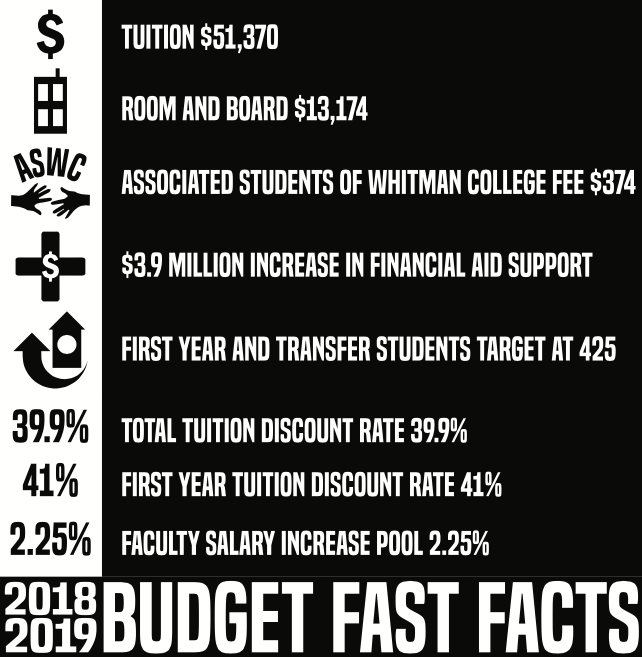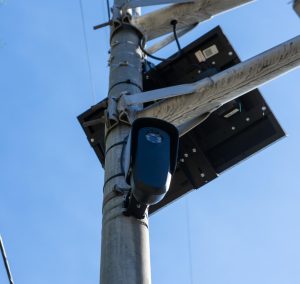2018-2019 Budget Sees Increased Discount Rate
April 24, 2018
With tuition now comfortably above $50,000 per year and dramatic reallocations towards financial aid, Whitman’s 2018-2019 budget budget is codified and ready for implementation on July 1.
Next year’s budget will see a serious push to make the Whitman experience affordable to more students, a commitment to financing the living facility improvements, and a desire to retain and attract faculty and staff through salary raises. This all comes in the context of Whitman’s under-enrollment pains; the changes are directed at providing some sort of solution.
The process of building the College’s budget always incorporates a lot of moving parts. The president’s cabinet began meeting last summer to develop top priorities which would inform the budget. Those priorities vary from year to year, and this year the newly minted strategic priorities took center stage. The 2018-2019 budget reflects the fact that those priorities were still being hammered out, as the strategic priorities have only recently been finalized.
Following this initial drafting period, departments authored budget requests for consideration. At the November meeting of the Board of Trustees, Chief Financial Officer Peter Harvey gave feedback on the previous fiscal year and then asked for Trustee approval on a set of ranges for items such as tuition increases, salary pools and other similar variables. Upon receiving approval, the president’s cabinet then got to work translating that all into dollars and cents.
With the departmental budget requests in hand, the president’s cabinet coordinated with the Budget Advisory Committee in order to prepare a draft to be presented at the February meeting of the Board of Trustees. At that meeting, the Trustees put it to a vote on the floor, receiving approval. The budget will be implemented at the beginning of the fiscal year on July 1, 2018.
According to Harvey, increasing financial aid was this year’s biggest budgetary goal. “The biggest thing is a significant increase in financial aid budgets, which reflects the realities of the last few classes that we have brought in,” he said.
The financial aid budget has been increased by roughly $3.9 million, and reflects what Harvey described as the “top strategic priority of trying to make a Whitman College education more affordable and accessible to as many students as possible.” Harvey continued, “We are not there yet, it’s a long term goal, but we are making progress.”
Much of that financial aid money will be spent changing the discount rate. The discount rate reflects how much of every tuition dollar is returned through financial aid. During the 2017-2018 fiscal year, the rate was 36.25 percent and the College hoped that the rate for the incoming class of 2021 would be 37 percent. Due to enrollment shortfall, however, the discount rate for the class of 2021 is closer to 42 percent. That mistake caused a near budgetary crisis this year, as Whitman had to use most of the year-long contingency fund.
Next year’s budget reflects an increased discount rate for both Whitman as a whole and the class of 2022. The former is expected to be 39.9 percent and the latter 41 percent. Though this is a marked increase from years past, it is still well below the national average of 49 percent.
Harvey hopes that over time, Whitman can rely more on the endowment and tuition increases to boost financial aid in order to increase accessibility. “For example, we would like to see more Pell eligible students, which is the lowest income in the federal financial aid program,” Harvey said.
However, the $3.9 million increase in financial aid did not come from nowhere. Rather, it is the product of some clever accounting to find small pockets of money to be reallocated.
According to Harvey, reallocation is a feature of every budget building process. But this year, it took a different tone.
“Frankly we were much more aggressive this year. We always do some reallocations, but typically it’s somewhere in the range of $100,000 to $200,000, and the last couple of years we have been far more aggressive to free up money for financial aid,” Harvey said.
The $851,000 of reallocations in the 2017-2018 budget pales in comparison to the $3,195,000 in next years. That money represents the lion’s share of financial aid increases.
Harvey explained that much of the reallocation comes from close reading of how various endowments are used. While some are specifically for financial aid, faculty lines and other narrow programs, others are more general. The president’s cabinet looked to the places of overlap; where the same program was drawing on narrowly tailored endowments as well as general funds.
“Some of the restricted endowments were not being used in their entirety, but they can only be used for that purpose. So we reduced the general operating budgets to generate savings their and allow those departments to spend the narrow endowments,” Harvey said.
The facilities and equipment budget takes the hardest hit, with $1,118,000 reallocated, followed by faculty compensation and other personal expenses which together represent $980,000.
Viewed in the context of under-enrollment, these seemingly discrete changes paint a more cohesive picture. The 2018-2019 budget is built around the assumption that Whitman will entice 425 first-year and transfer students. The fact that this is down from 435 last year does not mean that under enrollment is less of a problem, in fact it means the opposite.
“We budgeted for next year 1504 students. A few years ago we were more in the 1540 range, and we want to get back there. [In 2015,] we were hoping to get 415 and we ended up with 389, and the next year we set as a goal 435. We didn’t succeed. We have lowered the target to be more realistic, and 425 is sustainable and can get us to our goals,” Harvey said.
The college has decided that returning to our targeted enrollment will be made easier with a more economically diverse student body and improved living facilities, hence those changes to next year’s budget.
Vice President for Enrollment and Communications Josh Jensen said of the 425 target that it “reflects our belief that maintaining the current size of the college – that is the number of students we plan to enroll – is a realistic and sustainable goal.”
Jensen continued, “While we’ve had a few years of under-enrollment, we haven’t changed our fundamental idea about how many students Whitman should have. I also think this goal acknowledges that we’re focused on the long-term outlook and health of the college.”






